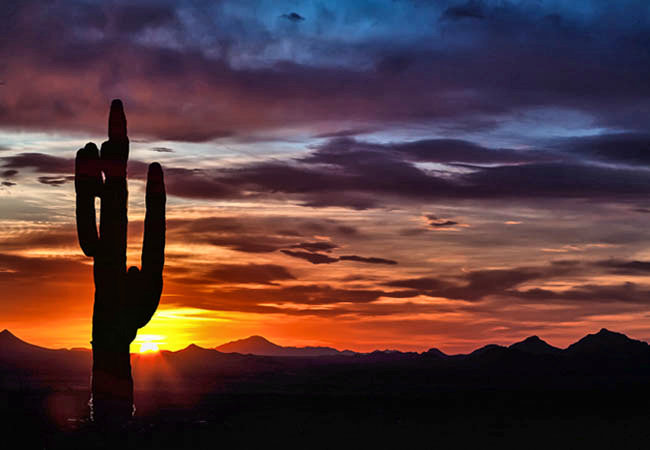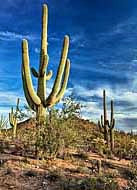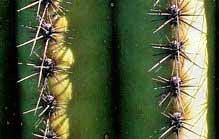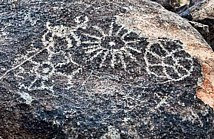|
Scenic USA - Arizona Saguaro Guardians |

| Photos by Marty Straub Marty's Saguaro National Park Gallery |
Although it takes more than a few programs to make Saguaro National Park a success, two groups  stand out with their important part in keeping the giant saguaro and cactus forest healthy. The park’s Junior Rangers, for kids ages 5 through 11, volunteer for simple service tasks as well as enjoying the fun stuff associated with the program. The idea of Cactus Rangers was born when Junior Rangers began to outgrow the original group. The award winning Cactus Rangers Program offers young people significant opportunities to learn about the desert, watch over Junior Rangers, and help with larger projects in the park. One mission helped rescue and transplant cactus destined to be removed for a road project. This group of rangers was quite excited to come back and see their transplants flourishing.
stand out with their important part in keeping the giant saguaro and cactus forest healthy. The park’s Junior Rangers, for kids ages 5 through 11, volunteer for simple service tasks as well as enjoying the fun stuff associated with the program. The idea of Cactus Rangers was born when Junior Rangers began to outgrow the original group. The award winning Cactus Rangers Program offers young people significant opportunities to learn about the desert, watch over Junior Rangers, and help with larger projects in the park. One mission helped rescue and transplant cactus destined to be removed for a road project. This group of rangers was quite excited to come back and see their transplants flourishing.
 While cactus spines keep most sensible people at a safe distance, desert poachers take advantage of these remote regions and valuable cactus. Another group includes special investigators, i.e. cactus cops. These agents from the Arizona Department of Agriculture help protect everything living thing in the state from cactus to cattle. Prized saguaros, selling for as much as 70 dollars a foot, are a hot commodity on the black market. It doesn’t take long for an experienced crew of thieves to dig up a huge cactus and load it onto a truck. As with most government agencies, lack of funding has the department scaling back on the number of agriculture agents at a time when they're needed the most. Today, the agency relies on education and hopes that homeowners think twice before purchasing bargain cactus.
While cactus spines keep most sensible people at a safe distance, desert poachers take advantage of these remote regions and valuable cactus. Another group includes special investigators, i.e. cactus cops. These agents from the Arizona Department of Agriculture help protect everything living thing in the state from cactus to cattle. Prized saguaros, selling for as much as 70 dollars a foot, are a hot commodity on the black market. It doesn’t take long for an experienced crew of thieves to dig up a huge cactus and load it onto a truck. As with most government agencies, lack of funding has the department scaling back on the number of agriculture agents at a time when they're needed the most. Today, the agency relies on education and hopes that homeowners think twice before purchasing bargain cactus.
Split into two districts, Saguaro National Park saw a huge increase to its acreage from the modest 1933 National Monument footprint. The size of the park grew to nearly 100,000 acres. Scenic drives and miles of hiking trails create convenient ways to learn more about the southern Arizona desert and it inhabitants.  While park-goers appreciate the iconic symbol of the American's Southwestern desert (the saguaro cactus) all year, springtime offers an added bonus when wildflowers blanket the desert floor. Breathtaking displays of Mexican poppy, penstemons, lupines, desert marigolds, brittlebushes and globe mallows add colors of red, lilac, blue, gold and yellow to the desert landscape. Trees and shrubs, such as creosote bushes, paloverdes, ocotillos, chollas, and hedgehog cactus are the more typical desert plants. Here among the jumping cholla (CHOY-a) and barrel cactus, the Hohokam Natives left behind a few calling cards etched into the surface of sandstone and other rocks. No one actually knows what these ancient petroglyphs meant to the Hohokam culture, but their intriguing designs continue to conjure up various theories about this ancient graffiti.
While park-goers appreciate the iconic symbol of the American's Southwestern desert (the saguaro cactus) all year, springtime offers an added bonus when wildflowers blanket the desert floor. Breathtaking displays of Mexican poppy, penstemons, lupines, desert marigolds, brittlebushes and globe mallows add colors of red, lilac, blue, gold and yellow to the desert landscape. Trees and shrubs, such as creosote bushes, paloverdes, ocotillos, chollas, and hedgehog cactus are the more typical desert plants. Here among the jumping cholla (CHOY-a) and barrel cactus, the Hohokam Natives left behind a few calling cards etched into the surface of sandstone and other rocks. No one actually knows what these ancient petroglyphs meant to the Hohokam culture, but their intriguing designs continue to conjure up various theories about this ancient graffiti.
Directions
Area Map
|
More Area Attractions |
|
Copyright © 2025 Benjamin Prepelka
All Rights Reserved
